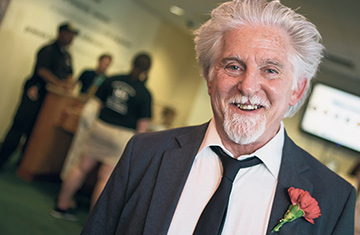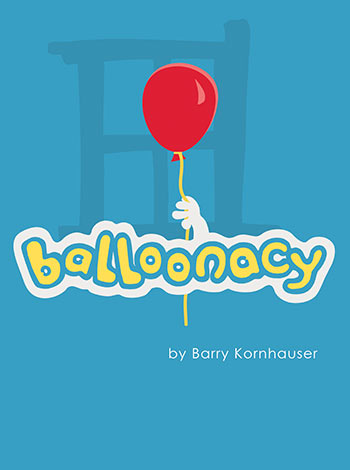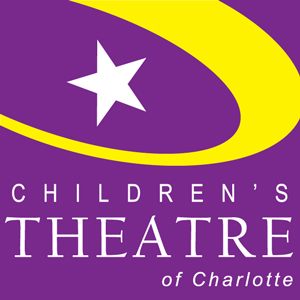Resource Guide - Balloonacy
Before the Show
Click on a topic to expand/hide content:
+ About the Show
+ The BIG Questions Before the Show
+ Activities
Pantomime
Pantomime is a type of acting using gestures and facial expressions but no sounds or words. Pantomime is prominent in the performance of Balloonacy. Lead students through a creative pantomime activity in the classroom. Encourage the class to act out the activity at once.
Describe an event or environment to students (we list suggestions below) and explain they’ll act out activities within this environment without using any words or sounds. After the class has had an opportunity to explore, ask the class to sit on the floor and encourage a few students to show their activity. See if the rest of the class can guess what they’re doing!
Masked emotions
Encouraging students to talk about feelings isn’t always easy. One way is to turn it into play. The goal of this activity is to play with and open up a dialogue about feelings with your students. What happens when you feel sad? How does your face change? Create a paper plate mask. Direct students to choose an emotion and decorate their masks as that emotion.
Tracing Exercise
Click the button to see a printable worksheet for your classroom or family.
Trace the Balloons
+ Meet Barry Kornhauser, playwright Barry Kornhauser's theatre honors include writing plays for both children and adults. He has won the Children's Theatre Foundation of America's Orlin Corey Medallion, the American Alliance for Theatre & Education (AATE) Charlotte Chorpenning Cup, Helen Hayes Award for Outstanding Play, and three AATE Distinguished Play Awards (This Is Not A Pipe Dream, Balloonacy, and Corduroy), as well as many others.
Barry Kornhauser's theatre honors include writing plays for both children and adults. He has won the Children's Theatre Foundation of America's Orlin Corey Medallion, the American Alliance for Theatre & Education (AATE) Charlotte Chorpenning Cup, Helen Hayes Award for Outstanding Play, and three AATE Distinguished Play Awards (This Is Not A Pipe Dream, Balloonacy, and Corduroy), as well as many others.
His youth theatre program for teens living with disabilities and other life challenges was honored at the White House as one of the nation's top arts-education initiatives. Closer to home, Barry was named Artist of the Year at the 2017 Pennsylvania Governor's Awards. Over the years, Barry has conducted theatre residencies everywhere from a one-room Amish schoolhouse to universities across the country.
Currently, he works for the Millersville University Office of Visual & Performing Arts. Prior to this, he served over 30 years as Playwright-In-Residence, TYA Director, and other positions at the National Historic Landmark Fulton Theatre.
+ About the Show
The Old Man lives alone in a small apartment in Paris. It’s his birthday, and he’s stopped speaking to anyone. His life is rather quiet and sad. But soon an insistent, red Balloon floats through the window and into his life. In contrast to the Old Man, Balloon is boisterous, playful and lighthearted. And he soon charms the Old Man. Balloonacy is a story that explores and celebrates the power of friendship!
Themes: Emotions, Making Friends, Five Senses, Opposites
+ The BIG Questions Before the Show
- Have you ever hurt someone’s feelings before? How did that make you feel? How did it make the other person feel?
- Do you have a special friend? What makes them special? What are games you like to play with your special friend?
Goal LDC-2: Children participate in conversations with peers and adults in one-onone, small, and larger group interactions. Goal CD-9: Children explore concepts connected with their daily experiences in their community.
+ Activities
Pantomime
Pantomime is a type of acting using gestures and facial expressions but no sounds or words. Pantomime is prominent in the performance of Balloonacy. Lead students through a creative pantomime activity in the classroom. Encourage the class to act out the activity at once.
Describe an event or environment to students (we list suggestions below) and explain they’ll act out activities within this environment without using any words or sounds. After the class has had an opportunity to explore, ask the class to sit on the floor and encourage a few students to show their activity. See if the rest of the class can guess what they’re doing!
- Birthday party
- Trip to the beach
- Visit to the library
- Going fishing
Goal HPD-4: Children develop the large muscle control and abilities needed to move through and explore their environment.
Masked emotions
Encouraging students to talk about feelings isn’t always easy. One way is to turn it into play. The goal of this activity is to play with and open up a dialogue about feelings with your students. What happens when you feel sad? How does your face change? Create a paper plate mask. Direct students to choose an emotion and decorate their masks as that emotion.
- Gather your materials. You will need half a paper plate per mask. You will also need Popsicle sticks, crayons or markers, scissors, and tape. Start by cutting the plates in half.
- Brainstorm some emotions with your class. You can list them on the board. Have the students write the emotion on the back of the plate.
- Decorate the masks! A happy mask might have bright colors. A sad mask might have darker colors.
- Tape the sticks onto the mask.
- Play with the emotions. See if you can make one emotion with your mask and another with your eyes.
Tracing Exercise
Click the button to see a printable worksheet for your classroom or family.
Trace the Balloons
+ Meet Barry Kornhauser, playwright
 Barry Kornhauser's theatre honors include writing plays for both children and adults. He has won the Children's Theatre Foundation of America's Orlin Corey Medallion, the American Alliance for Theatre & Education (AATE) Charlotte Chorpenning Cup, Helen Hayes Award for Outstanding Play, and three AATE Distinguished Play Awards (This Is Not A Pipe Dream, Balloonacy, and Corduroy), as well as many others.
Barry Kornhauser's theatre honors include writing plays for both children and adults. He has won the Children's Theatre Foundation of America's Orlin Corey Medallion, the American Alliance for Theatre & Education (AATE) Charlotte Chorpenning Cup, Helen Hayes Award for Outstanding Play, and three AATE Distinguished Play Awards (This Is Not A Pipe Dream, Balloonacy, and Corduroy), as well as many others.
His youth theatre program for teens living with disabilities and other life challenges was honored at the White House as one of the nation's top arts-education initiatives. Closer to home, Barry was named Artist of the Year at the 2017 Pennsylvania Governor's Awards. Over the years, Barry has conducted theatre residencies everywhere from a one-room Amish schoolhouse to universities across the country.
Currently, he works for the Millersville University Office of Visual & Performing Arts. Prior to this, he served over 30 years as Playwright-In-Residence, TYA Director, and other positions at the National Historic Landmark Fulton Theatre.
After the Show
Click on a topic to expand/hide content:
+ The BIG Questions After the Show
+ Activities
Pass the face
Instruct the class to stand in a circle. Choose one student to make a face (sad, happy, etc.), then have the student take it off and throw it to another student in the circle. Once the other student has caught it, he or she puts on that same face. That student now puts on a new face and then passes it to another person in the circle. For younger students, it may be helpful to pass the face to the person on his or her right or left and let it travel around the circle before creating a new face.
Balloon Olympics
This activity provides plenty of opportunities for running, jumping, counting and balancing. You could also have students make medals before the activities to celebrate with at the end. Please note: If your school has a policy regarding balloons and possible latex allergies, you can use mylar balloons, qualatex bubbles, or other non-latex options. We recommend young children NOT try to inflate balloons as they can be a choking hazard.
To have a good friend, you must BE a good friend.
Begin this activity by leading a discussion on the characteristics of a good friend. Then talk about the play and allow students to give examples about times when the Old Man showed he was becoming the balloon’s friend. Jumpstart your discussion by talking about some of these characteristics of good friends.
Writing Exercise
Click the button to see a printable worksheet for your classroom or family. Follow the letter B
+ Talk About Theatre Jobs
+ Recommended Reading
+ The BIG Questions After the Show
- Why do you think the Old Man in the story doesn’t speak?
- On what special day does this story take place? How did you know that day was special? What clues did you see?
- What does this story teach us about friendship? Can you remember specific events that happened in the story?
Goal LDC-2: Children participate in conversations with peers and adults in one-on-one, small, and larger group interactions. Goal CD-9: Children explore concepts connected with their daily experiences in their community.
+ Activities
Pass the face
Instruct the class to stand in a circle. Choose one student to make a face (sad, happy, etc.), then have the student take it off and throw it to another student in the circle. Once the other student has caught it, he or she puts on that same face. That student now puts on a new face and then passes it to another person in the circle. For younger students, it may be helpful to pass the face to the person on his or her right or left and let it travel around the circle before creating a new face.
Goal ESD-5: Children demonstrate the social and behavioral skills needed to successfully participate in groups.
Balloon Olympics
This activity provides plenty of opportunities for running, jumping, counting and balancing. You could also have students make medals before the activities to celebrate with at the end. Please note: If your school has a policy regarding balloons and possible latex allergies, you can use mylar balloons, qualatex bubbles, or other non-latex options. We recommend young children NOT try to inflate balloons as they can be a choking hazard.
- String up a rope or long scarf across the classroom and play volleyball.
- The rope is used to divide the room into two. Equal numbers of balloons are placed on each side of the rope, and two teams are formed and placed on either side of the rope. The timer is set and at the signal, each team tries to throw or hit the balloons to the other side. When the timer goes off, the team with the least amount of balloons on its side wins.
- Mark off an obstacle course in your classroom. Can students walk the entire course with a balloon between their legs?
- Have students balance a balloon on their fingertip for as long as they can.
- Have students count while bouncing a balloon against a bare wall. Increase the challenge by using one of these variations: stand on one leg, clap three times, or spin around before the balloon bounces back.
- Divide the class into teams. Each team must sort all of the balloons of one color into their space in the room. When the games are over, it’s time to celebrate! Reward your hard-working athletes with medals and a balloon popping finale!
Goal HPD-4: Children develop the large muscle control and abilities needed to move through and explore their environment. Goal CD-11: Children compare, sort, group, organize, and measure objects and create patterns in their everyday environment.
To have a good friend, you must BE a good friend.
Begin this activity by leading a discussion on the characteristics of a good friend. Then talk about the play and allow students to give examples about times when the Old Man showed he was becoming the balloon’s friend. Jumpstart your discussion by talking about some of these characteristics of good friends.
- Listen to each other.
- Build each other up rather than put each other down.
- Try to understand each other’s feelings.
- Help each other solve problems.
- Disagree without hurting each other.
- Care about each other.
- Are honest with each other.
Goal LDC-13: Children use writing and other symbols to record information and communicate for a variety of purposes.
Writing Exercise
Click the button to see a printable worksheet for your classroom or family. Follow the letter B
+ Talk About Theatre Jobs
Every play Children’s Theatre of Charlotte produces is created by a talented team of designers, technicians, actors, and a director. As a class, discuss what you experienced when you saw the performance.
- What was the first thing you noticed on the stage?
- Name three things you noticed about the scenery. Did the scenery help tell the story? What sort of scenery would you have designed?
- What did you like about the costumes? Did they fit the story? What sort of costumes would you have designed?
Goal CD-4: Children demonstrate appreciation for different forms of artistic expression. Goal LDC-2: Children participate in conversations with peers and adults in one-on-one, small, and larger group interactions.
+ Recommended Reading
If you enjoyed the show, travel to ImaginOn or your local Charlotte Mecklenburg Library branch and check out these books. Check availability at cmlibrary.org.
- Perfectly Percy by Paul Schmid
- Bird, Balloon, Bear by Il Sung Na
- Come Back, Ben by Ann Hassett
- My Red Balloon by Kazuaki Yamada
- Ball and Balloon by Rob Sanders

By Barry Kornhauser





